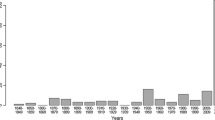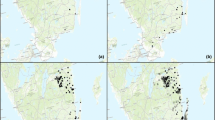Abstract
Pheromone monitoring could provide unique spatial and temporal information about rare and threatened insect species for conservation purposes. Pheromone traps may be especially valuable in detecting fluctuations and declines in vulnerable species, if trap catch can be related to population density. We exploited the pheromone-kairomone system of the hermit beetle Osmoderma eremita and its predator, the red click beetle Elater ferrugineus, to monitor variation in their flight activity during 7 years (2001–2002, 2005–2009). Spatial and temporal flight activity of O. eremita and E. ferrugineus were highly correlated over individual trap replicates and trap days. Yearly flight activities of both species were correlated within two core sites included during all years of the study, and positively affected by temperature both within and between years. Flight activity could not be directly translated to variation in abundance in either species, however. Dispersal rate was likely the main factor explaining flight activity in O. eremita. Normalizing the flight activity of E. ferrugineus against that of O. eremita did not eliminate most of the variability, however, suggesting that flight activity of E. ferrugineus was governed both by dispersal rate and by population density. Higher fluctuations in population density of E. ferrugineus likely render it more vulnerable to local extinction, which may explain the greater rarity of this species. We suggest that preserving large assemblies of suitable hollow trees would be absolutely essential for buffering against stochastic population fluctuations and securing the long-term persistence of E. ferrugineus.



Similar content being viewed by others
References
Angelibert S, Giani N (2003) Dispersal characteristics of three odonate species in a patchy habitat. Ecography 26(1):13–20
Anonymous (1992) Directive 92/43 of the Council of the European Community on the conservation of habitats and wild fauna and flora. European Community, Brussels
Blackshaw RP, Vernon RS (2006) Spatiotemporal stability of two beetle populations in non-farmed habitats in an agricultural landscape. J Appl Ecol 43(4):680–689
Bommarco R, Biesmeijer JC, Meyer B, Potts SG, Poyry J, Roberts SPM, Steffan-Dewenter I, Öckinger E (2010) Dispersal capacity and diet breadth modify the response of wild bees to habitat loss. Proc R Soc B 277(1690):2075–2082. doi:10.1098/rspb.2009.2221
Collier N, Mackay DA, Benkendorff K (2008) Is relative abundance a good indicator of population size? Evidence from fragmented populations of a specialist butterfly (Lepidoptera: Lycaenidae). Popul Ecol 50(1):17–23
Craig CC (1953) On the utilization of marked specimens in estimating populations of flying insects. Biometrika 40(1–2):170–176
Driscoll DA (2010) Few beetle species can be detected with 95% confidence using pitfall traps. Austral Ecol 35(1):13–23. doi:10.1111/j.1442-9993.2009.02007.x
Franzén M, Larsson M, Nilsson S (2009) Small local population sizes and high habitat patch fidelity in a specialised solitary bee. J Insect Conserv 13(1):89–95
Gandhi KJK, Gilmore DW, Haack RA, Katovich SA, Krauth SJ, Mattson WJ, Zasada JC, Seybold SJ (2009) Application of semiochemicals to assess the biodiversity of subcortical insects following an ecosystem disturbance in a sub-boreal forest. J Chem Ecol 35(12):1384–1410. doi:10.1007/s10886-009-9724-3
Guichard S, Kriticos DJ, Leriche A, Worner SP, Kean JM, Suckling DM (2010) Evidence of active or passive downwind dispersal in mark-release-recapture of moths. Entomol Exp Appl 134(2):160–169. doi:10.1111/j.1570-7458.2009.00950.x
Hanski I (1998) Metapopulation dynamics. Nature 396(6706):41–49
Harvey DJ, Hawes CJ, Gange AC, Finch P, Chesmore D, Farr I (2010) Development of non-invasive monitoring methods for larvae and adults of the stag beetle, Lucanus cervus. Insect Conserv Divers (in press). doi:10.1111/j.1752-4598.2009.00072.x
Hedin J, Ranius T, Nilsson SG, Smith HG (2008) Restricted dispersal in a flying beetle assessed by telemetry. Biodivers Conserv 17(3):675–684
Henry PY, Lengyel S, Nowicki P, Julliard R, Clobert J, Celik T, Gruber B, Schmeller D, Babij V, Henle K (2008) Integrating ongoing biodiversity monitoring: potential benefits and methods. Biodivers Conserv 17(14):3357–3382
Holland JM, Thomas CFG, Birkett T, Southway S, Oaten H (2005) Farm-scale spatiotemporal dynamics of predatory beetles in arable crops. J Appl Ecol 42(6):1140–1152
Jansson N, Ranius T, Larsson A, Milberg P (2009) Boxes mimicking tree hollows can help conservation of saproxylic beetles. Biodivers Conserv 18(14):3891–3908. doi:10.1007/s10531-009-9687-2
Johnson DM, Liebhold AM, Tobin PC, Bjornstad ON (2006) Allee effects and pulsed invasion by the gypsy moth. Nature 444(7117):361–363
Kery M, Spillmann JH, Truong C, Holderegger R (2006) How biased are estimates of extinction probability in revisitation studies? J Ecol 94(5):980–986. doi:10.1111/j.1365-2745.2006.01151.x
Kikkert JR, Hoepting CA, Wu QJ, Wang P, Baur R, Shelton AM (2006) Detection of Contarinia nasturtii (Diptera: Cecidomyiidae) in New York, a new pest of cruciferous plants in the United States. J Econ Entomol 99(4):1310–1315
Larsson MC, Svensson GP (2009) Pheromone monitoring of rare and threatened insects: exploiting a pheromone-kairomone system to estimate prey and predator abundance. Conserv Biol 23(6):1516–1525
Larsson MC, Hedin J, Svensson GP, Tolasch T, Francke W (2003) Characteristic odor of Osmoderma eremita identified as a male-released pheromone. J Chem Ecol 29(3):575–587
Larsson MC, Svensson GP, Ryrholm N (2009) Box: monitoring rare and threatened insects with pheromone attractants. In: Samways MJ, New T, McGeoch M (eds) Insect conservation: a handbook of approaches and methods. Oxford University Press, Oxford, UK, pp 114–116
Lotts KC, Waite TA, Vucetich JA (2004) Reliability of absolute and relative predictions of population persistence based on time series. Conserv Biol 18(5):1224–1232
Millar JG, McElfresh JS, Romero C, Vila M, Mari-Mena N, Lopez-Vaamo C (2010) Identification of the sex pheromone of a protected species, the Spanish moon moth Graellsia isabellae. J Chem Ecol 36:923–932. doi:10.1007/s10886-010-9831-1
Nilsson SG, Baranowski R (1997) Habitat predictability and the occurrence of wood beetles in old-growth beech forests. Ecography 20(5):491–498
Oleksa A, Gawronski R (2008) Influence of day time and weather conditions on the activity of the hermit beetle, Osmoderma eremita Scop., and their consequences for monitoring (Wpyw pogody i pory dnia na aktywnosc pachnicy debowej (Osmoderma eremita Scop.) oraz ich konsekwencje dla monitoringu.). Parki Narodowe i Rezerwaty Przyrody 27(3):63–73
Östrand F, Anderbrant O (2003) From where are insects recruited? A new model to interpret catches of attractive traps. Agric For Entomol 5(2):163–171
Ovaskainen O, Smith AD, Osborne JL, Reynolds DR, Carreck NL, Martin AP, Niitepold K, Hanski I (2008) Tracking butterfly movements with harmonic radar reveals an effect of population age on movement distance. Proc Natl Acad Sci USA 105(49):19090–19095
Palmqvist E, Lundberg P, Jonzen N (2000) Linking resource matching and dispersal. Evol Ecol 14(1):1–12
Ranius T (2001) Constancy and asynchrony of Osmoderma eremita populations in tree hollows. Oecologia 126(2):208–215
Ranius T (2002) Osmoderma eremita as an indicator of species richness of beetles in tree hollows. Biodivers Conserv 11(5):931–941
Ranius T (2006) Measuring the dispersal of saproxylic insects: a key characteristic for their conservation. Popul Ecol 48(3):177–188
Ranius T (2007) Extinction risks in metapopulations of a beetle inhabiting hollow trees predicted from time series. Ecography 30(5):716–726
Ranius T, Hedin J (2001) The dispersal rate of a beetle, Osmoderma eremita, living in tree hollows. Oecologia 126(3):363–370
Ranius T, Jansson N (2002) A comparison of three methods to survey saproxylic beetles in hollow oaks. Biodivers Conserv 11(10):1759–1771
Ranius T, Aguado LO, Antonsson K, Audisio P, Ballerio A, Carpaneto GM, Chobot K, Gjurasin B, Hanssen O, Huijbregts H, Lakatos F, Martin O, Neculiseanu Z, Nikitsky NB, Paill W, Pirnat A, Rizun V, Ruicnescu A, Stegner J, Süda I, Szwako P, Tamutis V, Telnov D, Tsinkevich V, Versteirt V, Vignon V, Vögeli M, Zach P (2005) Osmoderma eremita (Coleoptera, Scarabaeidae, Cetoniidae) in Europe. Animal Biodivers Conserv 28(1):1–44
Ranius T, Svensson GP, Berg N, Niklasson M, Larsson MC (2009) The successional change of hollow oaks affects their suitability for an inhabiting beetle, Osmoderma eremita. Ann Zool Fenn 46(3):205–216
Rouquette JR, Thompson DJ (2007) Patterns of movement and dispersal in an endangered damselfly and the consequences for its management. J Appl Ecol 44(3):692–701
Samways MJ, Lu SS (2007) Key traits in a threatened butterfly and its common sibling: implications for conservation. Biodivers Conserv 16(14):4095–4107
Schultz CB, Hammond PC (2003) Using population viability analysis to develop recovery criteria for endangered insects: case study of the Fender’s blue butterfly. Conserv Biol 17(5):1372–1385
Svensson GP, Larsson MC (2008) Enantiomeric specificity in a pheromone-kairomone system of two threatened saproxylic beetles, Osmoderma eremita and Elater ferrugineus. J Chem Ecol 34(2):189–197
Svensson GP, Larsson MC, Hedin J (2004) Attraction of the larval predator Elater ferrugineus to the sex pheromone of its prey, Osmoderma eremita, and its implication for conservation biology. J Chem Ecol 30(2):353–363
Svensson GP, Oleksa A, Gawronski R, Lassance JM, Larsson MC (2009) Enantiomeric conservation of the male-produced sex pheromone facilitates monitoring of threatened European hermit beetles (Osmoderma spp.). Entomol Exp Appl 133(3):276–282
Thomas CD (1994) Extinction, colonization, and metapopulations—environmental tracking by rare species. Conserv Biol 8(2):373–378
Thomas JA (2005) Monitoring change in the abundance and distribution of insects using butterflies and other indicator groups. Philos Trans R Soc B-Biol Sci 360(1454):339–357
Thomas JA, Telfer MG, Roy DB, Preston CD, Greenwood JJD, Asher J, Fox R, Clarke RT, Lawton JH (2004) Comparative losses of British butterflies, birds, and plants and the global extinction crisis. Science 303(5665):1879–1881
Tolasch T, von Fragstein M, Steidle JLM (2007) Sex pheromone of Elater ferrugineus L. (Coleoptera : Elateridae). J Chem Ecol 33(11):2156–2166
Travis JMJ, Dytham C (1999) Habitat persistence, habitat availability and the evolution of dispersal. Proc R Soc Lond Ser B-Biol Sci 266(1420):723–728
Turner JRG, Gatehouse CM, Corey CA (1987) Does solar-snergy control organic diversity—butterflies, moths and the British climate. Oikos 48(2):195–205
Wahlberg N, Klemetti T, Selonen V, Hanski I (2002) Metapopulation structure and movements in five species of checkerspot butterflies. Oecologia 130(1):33–43
Witzgall P, Kirsch P, Cork A (2010) Sex pheromones and their impact on pest management. J Chem Ecol 36(1):80–100. doi:10.1007/s10886-009-9737-y
Acknowledgments
We are grateful to Kajsa Mellbrand, Jonas Hedin, Annelie Andersson, Karin Loqvist, Björn Brage, Marie Garstad, Therese Lindström, Niclas Berg, Hedvig Boreson, Gunilla Ångström-Balla, and Frida Johansson for field assistance; to Jan-Eric Englund for statistical advice; to Thomas Ranius and one anonymous referee for improving the manuscript; to SMHI for weather data; to landowners Oscar Ekman and Henric Falkenberg for allowing access to their property. This study was supported by Stiftelsen Eklandskapet i Linköpings kommun, Bergvalls Stiftelse, Lunds Djurskyddsfond, Bjärka-Säbystiftelsen, the Linnaeus initiative Insect Chemical Ecology, Ethology, and Evolution (ICE3), and strategic funds from the vice chancellor at Lund University for collaboration with Swedish University of Agricultural Sciences.
Author information
Authors and Affiliations
Corresponding author
Rights and permissions
About this article
Cite this article
Larsson, M.C., Svensson, G.P. Monitoring spatiotemporal variation in abundance and dispersal by a pheromone-kairomone system in the threatened saproxylic beetles Osmoderma eremita and Elater ferrugineus . J Insect Conserv 15, 891–902 (2011). https://doi.org/10.1007/s10841-011-9388-5
Received:
Accepted:
Published:
Issue Date:
DOI: https://doi.org/10.1007/s10841-011-9388-5




